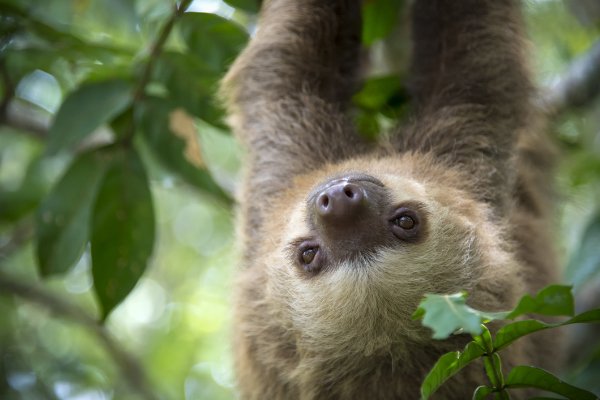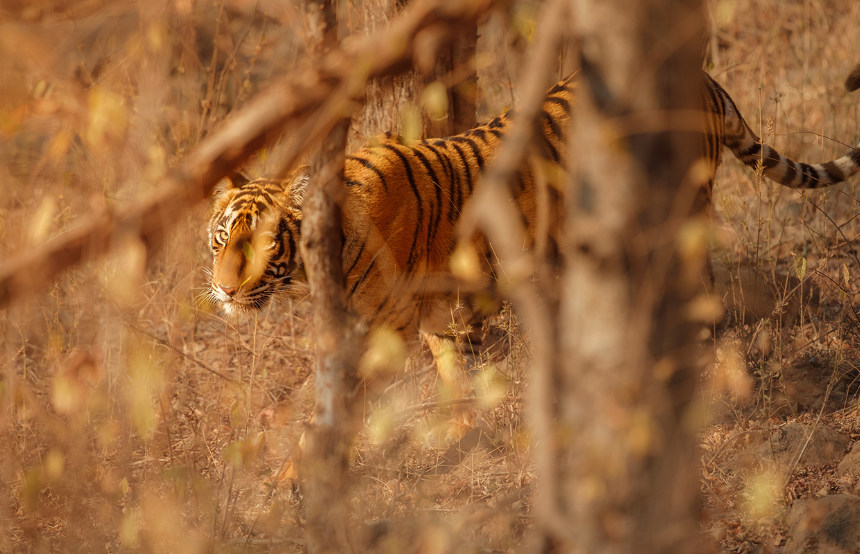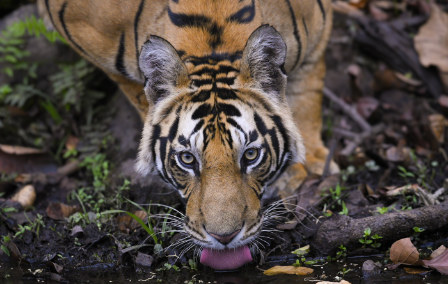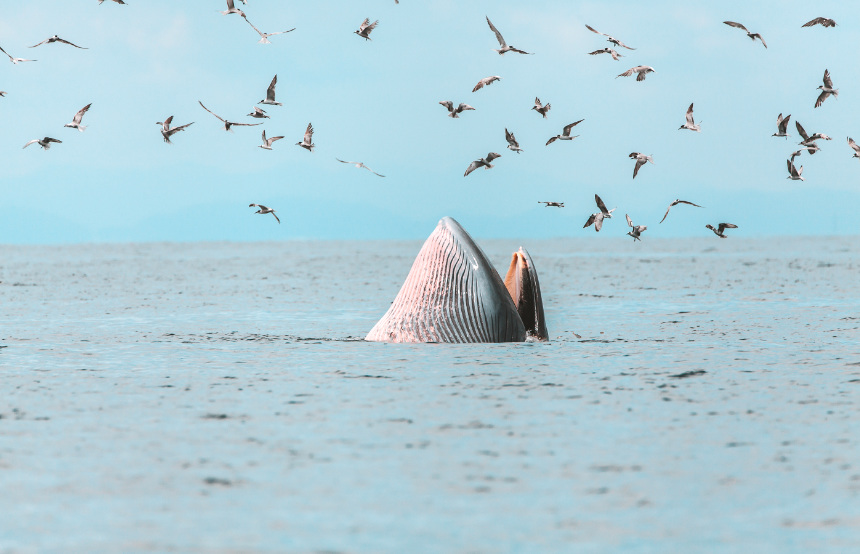Published 30th Jan. 2024
Reading time
Sloths are admired for their laidback lifestyles, which involves hanging out in the trees and doing very little else. Named after one of the seven deadly sins, these idle animals dwell in the tropical rainforests of Central and South America, drawn to the warm, humid climate that they find in the canopies. And while true that the sleepy sloth spends a lot of time above ground, there’s method in its (lack of) movement. Discover that there’s more to these creatures than meets the eye with the top eight sloth facts…
1. Sloth species
2. Tree-huggers
3. Toilet tales
4. Fantastic fur
5. Measured metabolism
6. Aquatic ability
7. Avocado advocates
8. Variable vision
1.
Our sluggish friends can be split up into two families: three-toed and two-toed sloths. Out of four three-toed sloth species, the brown-throated sloth is the most common, while there are just two species of two-toed sloths. The main difference between them? Well, the clue’s in their names. Counting toes aside, you can tell the sloth species apart from their size: two-toed sloths are slightly larger than their counterparts. You’re also more likely to see the two-toed variety in the wild, as sadly the pygmy three-toed sloth is critically endangered, and the maned three-toed sloth is on the vulnerable list.
2.
Contrary to popular opinion, sloths only actually snooze for eight to ten hours per day. A sloth fact which may come as a surprise is that their sleeping habits are not dissimilar to ours (if we swapped beds for branches). Who knew sloths were so relatable? It’s true, however, that the mammals do spend most of their lives suspended in the trees. They spend as much as 15-20 hours of every day hanging motionless or moving slowly between branches. Sloths grip on to branches with their long, curved claws, using their considerable strength – over three times stronger than the average human – to hang without exerting energy.

3.
For sloths, everything from eating to giving birth happens among the leaves. In fact, sloths are so fond of trees, that the only time they will descend from the branches is to defecate. A curious habit that has been baffling scientists for years, sloths journey to the forest floor to do the deed once a week. Given that they’re defenceless while on the ground, sloths put their lives at risk every time nature calls. It’s no surprise they prefer to stay up high.
4.
Say what you want about a sloth’s appearance, but there’s no denying they’ve got a good head (and body) of hair. And did you know that this fur hosts an entire world of its own? Owing to the green algae which thrives there, sloth fur houses a variety of insects, microbes and fungi – some of which are found nowhere else in the world. While we could definitely think of nicer places to call home, we can still appreciate this sloth fact. Sloths’ green fur even helps with survival, camouflaging the creature from the preying eyes of predators.
5.
Boasting the slowest metabolic rate of any animal, it can take a sloth up to 30 days to digest a single leaf. As folivores, the sedate sloth’s diet consists of leaves, fruits and sap from trees, which is all digested in their special multi-chambered stomach. Sloths’ slow metabolism allows them to conserve energy and survive on scarce amounts of food, but also makes them more susceptible to shifting environmental temperatures.

6.
Here’s another surprising sloth fact: did you know they’re fantastic swimmers, moving three times faster in water than on the ground? In contrast to the difficulty of the tree-dwellers’ lives on the ground, sloths have a natural buoyancy and can hold their breath for up to 40 minutes underwater. Dropping from canopies into bodies of water below, sloths can skilfully swim large distances when on the search for new partners, or new canopies to call home.
7.
Next time you tuck into the creamy flesh of an avocado, think of the sloth and its ancestors. We have the extinct giant ground sloth to thank for our favourite brunch component. These ancient creatures were the only mammals with stomachs large enough to be able to swallow an avocado seed whole. These feasting habits dispersed avocados seeds far and wide, bringing us all the delicious fruit we know today.
8.
Our final sloth fact relates to the mammal’s vision. As colourblind creatures, sloths struggle to see in dim light, and can’t see at all in bright daylight. Confined to the branches, this daylight blindness doesn’t seem to hinder their survival. Luckily, sloths have a wonderful sense of smell and spatial memory to compensate. Given that they’ve existed for over 65 million years, they seem to be faring just fine without 20/20 vision.
Written by Hannah Whitehall
Practical advice and inspiration for your next trip

Searching for the best safaris in India? We’ve got you covered. Whether you’re keen to track tigers in Madhya Pradesh, admire Asiatic lions in Gujarat or photograph forest eagle owls in Kerala, your India holiday awaits. While Bengal tigers steal the limelight in Bandhavgarh National Park, don’t forget about the shaggy sloth bears (though they’re not as cuddly as they look). Feeling up for the adventure?
15th September 2025 - India Safari & Wildlife

With their sleek, tangerine-tinged coats, piercing eyes and commanding presence, nothing beats the thrill of seeing a tiger in the wild. And where better than in India, home to the largest population on Earth? But when it comes to the best time to see tigers in India, it all depends on what you want from your trip. Whether you’d rather vivid green landscapes or crowd-free safaris, we’ve got the insider intel on when to see India’s famous big cats.
23rd June 2025 - India Safari & Wildlife

Where are the best places for whale watching? We’re glad you asked. From the picturesque Icelandic town of Husavik to the coastal haven of Mirissa in Sri Lanka, there are plenty of destinations to marvel at these majestic creatures. Picture this: the air is still and all you can hear is the creaking of the catamaran and the odd, excited whisper. You scan the horizon, desperate to spot the tip of a fluke or a distant plume of whale breath.
16th June 2025 - Safari & Wildlife

Our team of destination experts will get to know you and your unique requirements for your holiday

We work with you to build an ultra-personalised holiday itinerary with your choice of accommodation, experiences and activities

All of our holidays include little extras designed to make a big difference to your trip, from fast-tracking you through airport check-in and security to our network of local Concierges